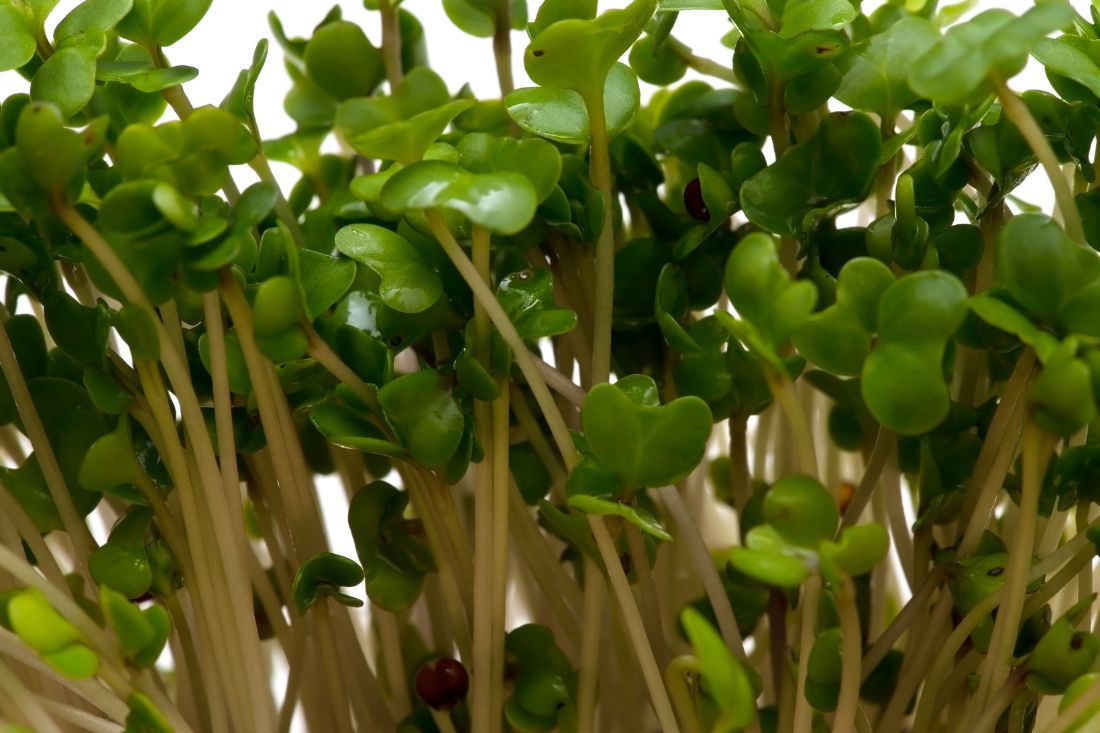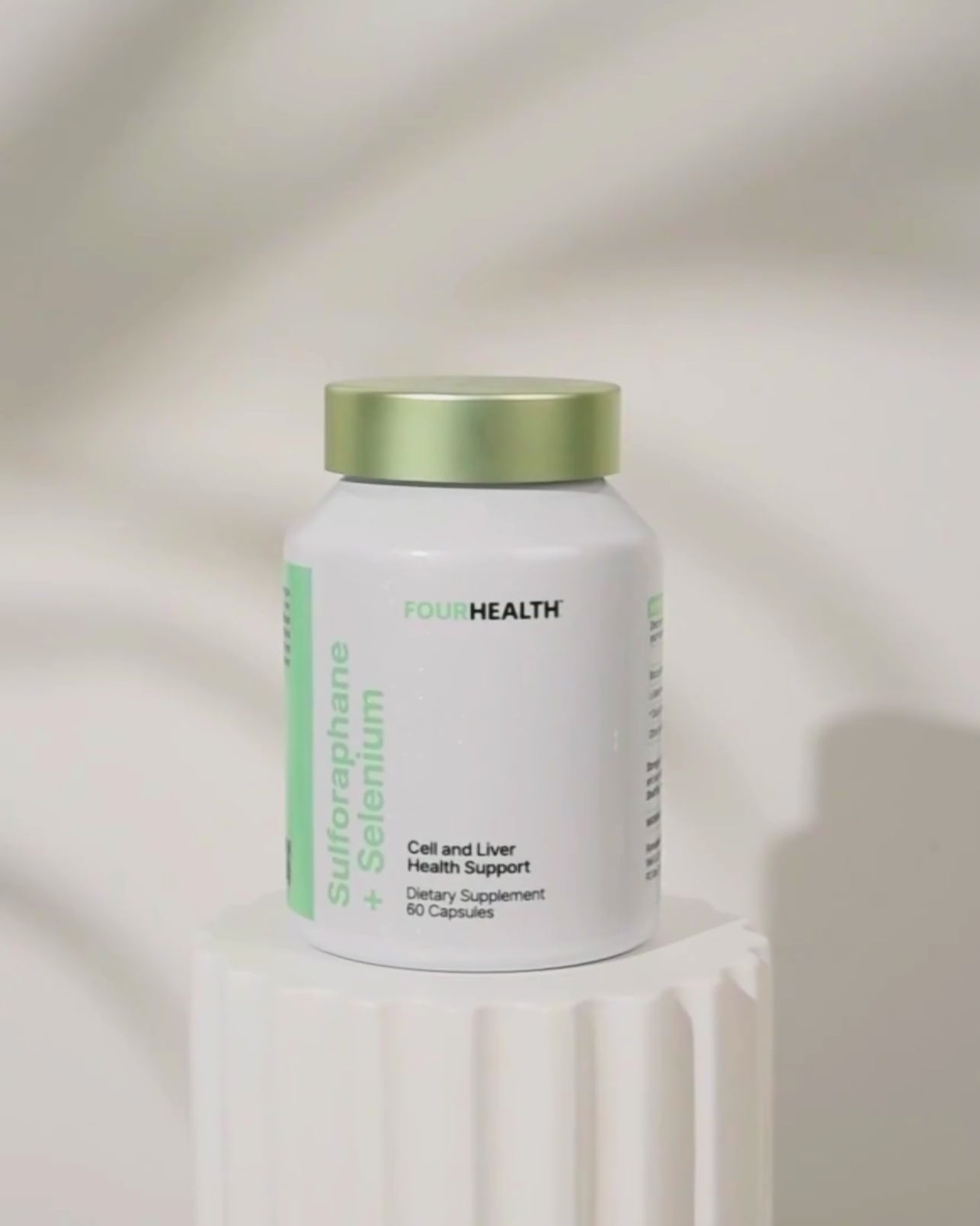Right, let’s get into the technical stuff now.
It’s complicated but, if you’re as excited about this as we are, read on.
Sulforaphane is one of the most important phytonutrients to have been discovered in the past 30 years. It is a key active phytochemical found in cruciferous vegetables like broccoli sprouts, cabbage, cauliflower, kale and bok choy.
Sulforaphane is activated when glucoraphanin (pronounced glue-core-raf-a-nin) and myrosinase (my-ro-sy-nase) come together - typically when a cruciferous vegetable is eaten or chewed. The presence of myrosinase is critical to transforming the glucoraphanin into Sulforaphane.
Broccoli sprouts contain the strongest concentration of glucoraphanin and myrosinase, and the maximum concentration of Sulforaphane occurs in
three-day-old broccoli sprouts. That’s why we use them in FourHealth Green+ and guarantee powerful dosing. So many supplements available today are at
low doses compared to those in clinical trials. Each dose of FourHealth Green+
(2 capsules), contains at least 14mg of Sulforaphane – a similar dose to what is used in clinical studies.

Sulforaphane as an Antioxidant
Antioxidants come up a lot in conversation nowadays and Sulforaphane is one of the most potent antioxidants available, albeit that it is what is known as an indirect antioxidant (Ie. It’s one which supports your body to produce antioxidants instead of introducing them directly). It stimulates production of a protein called Nrf2 which is the master protein that signals the body to produce a cascade of antioxidants.
This cascade of antioxidant production has powerful effects on the body – it’s a very dramatic detoxifier, it quells and resolves inflammation and even protects the brain. It builds stronger mitochondria too, which means a stronger brain and body as we age.
Remember that protein we mentioned above called Nrf2. This little guy is usually sleeping but when stress, inflammation or another signal hits your body, Nrf2 wakes up and gets to work. It binds to something called the antioxidant response element (ARE), the master switch that controls antioxidant production. When ARE turns on, your cells start pumping out antioxidants and detox compounds like glutathione, quinone reductase and a cascade of other antioxidants, quieting inflammation and protecting you against stress and damage.
So as you can see, the key to starting this whole process is waking up Nrf2. Sulforaphane is a potent Nrf2 activator, freeing the Nrf2 protein to turn on your antioxidant production. This pathway affects your whole body, which is why Sulforaphane helps in so many ways.
How It Helps You
Oxidative stress occurs when free radicals enter or are created within the body and cause unwanted oxidation. The body knows these oxidative residues and free radicals are harmful so creates an inflammatory response to resolve the threat, which is good as long as the inflammation is resolved.
Sulforaphane supports this, enhancing the production of enzymes that reduce oxidative stress.
The most common free radicals are called Reactive Oxygen Species and it is these that may cause DNA damage. The body manages oxidative stress by an immune response. Maintaining oxidative (redox) balance is key to maintaining good health. Sulforaphane supports heart and respiratory health in a number of ways, primarily due to its ability to increase anti-oxidant enzymes where they are needed in the body.
Sulforaphane boasts an extensive list of benefits for many illnesses and there is a substantial amount of scientific research to back this up, suggesting some remarkable possibilities.
On-Going Research
Sulforaphane first was stumbled upon by Dr Paul Talalay, a pharmacologist at Johns Hopkins University in Baltimore in the early 1990’s. He had encountered his first cancer patient in medical school and by the late 1980’s had begun to cultivate a “daring thought that cancers of all sorts might actually be preventable”.
Dr Talalay oversaw research that revealed intriguing qualities of Sulforaphane, a compound found in broccoli and in even greater quantities in broccoli sprouts. When ingested, he found sulforaphane binds to a protein inside cells, an event that sparked the increased production of enzymes that help cells resist toxic substances, including carcinogens.
He described the consumption of broccoli and other cruciferous vegetables as a “molecular defense” against “environmental insults” which had a “broad impact both in biomedical research and in influencing what people eat to stay healthy”.
A clinical pharmacologist at Johns Hopkins said Dr Talalay’s work and subsequent studies have shown potential benefits of sulforaphane for conditions far beyond cancer, including diabetes and autism, boosting immune response, protection against the ageing process and many more.
Sulforaphane continues to be one of the most researched natural health products in the scientific world, primarily for its potential in preventative health. Hundreds of research papers are published each year outlining the benefits of this extraordinary phytonutrient.







